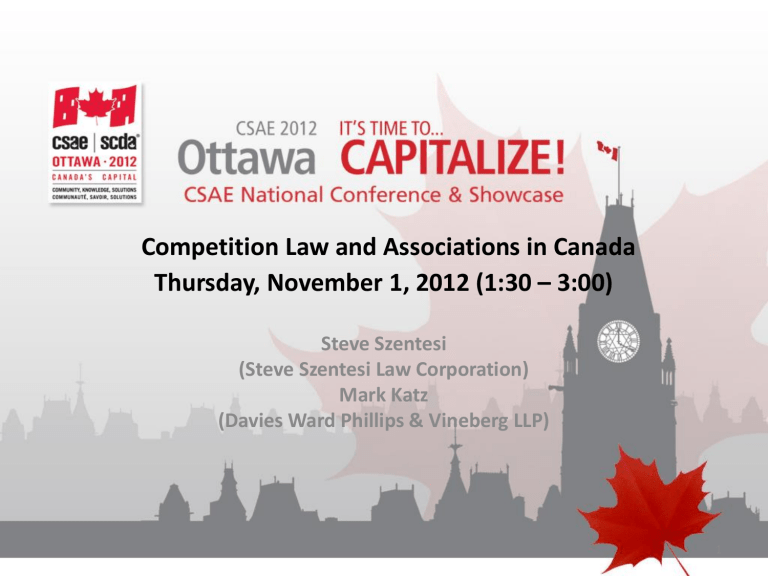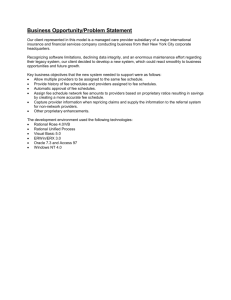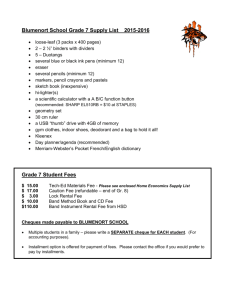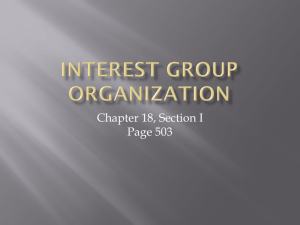Competition Law and Associations in Canada

Competition Law and Associations in Canada
Thursday, November 1, 2012 (1:30 – 3:00)
Steve Szentesi
(Steve Szentesi Law Corporation)
Mark Katz
(Davies Ward Phillips & Vineberg LLP)
1
Steve Szentesi
(604.601.2047/www.competitionlawcanada.com)
• Steve Szentesi practices competition law in Vancouver and Toronto and has provided advice in relation to a wide range of competition and regulatory matters.
• Steve has worked at leading business law firms in Vancouver, Toronto and London, taught competition law at the University of British Columbia for three years and was in-house competition counsel for The Canadian Real Estate Association.
• Steve is the co-author with Mark Katz of The Competition Law Guide for Trade
Associations in Canada and author and instructor of a national competition course for Canadian real estate boards.
• Recent matters include domestic and cross-border cartel cases, trade association compliance, advertising law advice and Investment Canada Act advice in relation to the BHP/Potash, Glencore/Viterra and CNOOC/Nexen mergers for U.S. and
European hedge funds.
2
Mark Katz
(416.863.5578/mkatz@dwpv.com)
• Mark Katz is a partner in the Competition & Foreign Investment Review practice of
Davies Ward Phillips & Vineberg LLP.
• Mark advises domestic and international clients on a wide variety of competition law matters, such as mergers and acquisitions, criminal cartel investigations, joint ventures, abuse of dominance, distribution and pricing practices, misleading advertising and compliance.
• Mark also provides advice with respect to the application of the Investment
Canada Act and other legislation governing foreign investment in Canada.
• Mark has appeared at every level of court in relation to competition matters, including the Supreme Court of Canada, and has acted as counsel on several leading cases before the Competition Tribunal, including the first abuse of dominance and merger cases heard by that body.
• Mark is the co-author with Steve Szentesi of The Competition Law Guide for Trade
Associations in Canada. Mark also publishes and speaks widely in the field of competition law and foreign investment review.
3
Agenda
• Overview:
– Trade Associations Under Scrutiny
– The Competition Act
• Specific Issues:
– Hard Core Conduct
– Fee Schedules & Compensation
– Data Collection and Information Exchanges
– Association Membership
– Other Risky Areas
• Bottom Line
4
OVERVIEW
5
Trade Associations Under Scrutiny
• The benefits of trade/professional associations are widely acknowledged:
– represent members to government, enhance business safety standards, engage in industry-wide promotion and education
• And yet…
6
Trade Associations Under Scrutiny
• Trade associations are a frequent target of competition enforcement action
• Irresistible combination of opportunity and temptation
7
Trade Associations Under Scrutiny
• Adam Smith summed it all up in An Inquiry into the Nature
and Causes of the Wealth of Nations:
"People of the same trade seldom meet, even for merriment or diversion, but the conversation ends in a conspiracy against the public or in some contrivance to raise prices."
8
Trade Associations Under Scrutiny
• Recent examples of associations in trouble:
– France: endive growers
– Greece: flour producers
– Italy: pasta manufacturers; notaries/lawyers
– Israel: nursery schools
– Ireland: car dealers
– Spain: press photographers; natural gas companies
– U.K.: dentists
– U.S.: egg/potato producers; ductile pipe manufacturers
9
Trade Associations Under Scrutiny
• Canadian competition law has been concerned with the conduct of trade and professional associations from the start
• By one count, trade associations have been implicated in over
50 competition cases in Canada, involving a wide range of industries and activities
10
Recent Bureau Statements
• Interim Commissioner John Pecman (Oct 30 th speech):
• “Trade associations … face unique compliance issues. They are naturally exposed to greater risks of anti-competitive behaviour because they provide a forum that may encourage competitors to collaborate. For this reason, compliance programs are of the utmost importance to trade associations.”
• Reiterates historical Competition Bureau recommendation for association compliance programs
11
Recent Bureau Statements
• Interim Commissioner John Pecman:
• 3 types of conduct likely to generate Bureau interest:
1. Restrictions on service / practice offerings
2. Limiting members’ ability to compete
3. Reducing incentives to compete
• Also cautions in relation to:
– Information exchanges
– Ensuring appropriate process for association activities
– Alternatives to fee guidelines
12
The Competition Act
• Federal legislation/no provincial counterpart
• Administered and enforced by Commissioner of Competition
(head of Competition Bureau)
• Criminal offences/civil reviewable practices
• Key prohibitions:
– Criminal conspiracies (anti-competitive agreements between competitors)
– Abuse of dominance
– Misleading advertising
– Distribution-related practices
13
The Competition Act
• Consequences of violations are very serious:
– Fines
– Jail
– Behavioural orders
– Civil damages
– Subject to intrusive investigations
14
SPECIFIC ISSUES
15
Hard Core Conduct
•
Most proceedings against associations are for so-called "hard core" conduct, involving prohibited agreements between competitors:
– Price-fixing
– Market allocation
– Output restrictions
– Bid-rigging
16
Hard Core Conduct (cont'd)
•
Criminal Offences
– Section 45 (criminal conspiracies) and section 47
(bid-rigging)
– No requirement to show anticompetitive effects
("per se")
•
Competition Bureau enforcement priority
17
Hard Core Conduct (cont'd)
• "Agreement" interpreted broadly for these purposes:
– Need not be in writing
– Need not be formal
– Need not actually be implemented
– Can be proven on basis of circumstantial evidence
• Rules, policies, by-laws or other initiatives enacted by a trade association can constitute "agreement" between competitors
18
Hard Core Conduct (cont'd)
• Examples:
– R. v. Armco Canada Ltd. ("open price policy")
– R. v. Alberta Ambulance Operators' Association (market allocation)
– Saskatchewan Roofing Contractors (bid-rigging)
– R. v. Burrows (restrictions on imports)
• Role of Association
– Central facilitator of conduct
– Used as a "cover" for illegal conduct (informal meetings)
19
Hard Core Conduct (cont'd)
• BEST PRACTICES:
• DO NOT adopt any form of policy, plan, program, arrangement or rule that involves "naked" price fixing, market allocation, output restrictions, bidrigging
• DO NOT permit the discussion of these matters at formal meetings:
– DO prepare agendas in advance and stick to them
– DO NOT allow meetings to become hijacked
– DO keep minutes
– DO consider having counsel present
• DO caution members not to engage in inappropriate discussions in any informal encounters
20
Fee Schedules & Compensation
• Associations sometimes formulate and adopt fee schedules for members
• Possible issues relating to:
– Mandatory fee schedules
– Voluntary or suggested fee guidelines
– Collective negotiations
21
Fee Schedules & Compensation –
Mandatory Fee Schedules
• Many association prosecutions based on adoption of mandatory fee schedules – e.g.:
– R. v. Howard Smith Paper Mills Ltd.
– R. v. B.C. Professional Pharmacists’ Society
– R. v. Kent County Law Association
• Some pre-2010 Competition Act amendment cases unsuccessful based on failure to prove competitive effects under former section
45
• Competitive effects test no longer required – i.e., lower enforcement bar
22
Fee Schedules & Compensation –Fee
Schedules
• BEST PRACTICES:
• DO NOT adopt mandatory fee schedules
• DO consider possible alternatives to voluntary fee schedules
• IF your association decides to adopt a voluntary fee schedule:
– DO state clearly that the schedule is for information purposes only and not mandatory
– DO NOT promote compliance with schedule
– DO NOT monitor or impose sanctions for non-compliance
– DO establish guidelines to guard against inappropriate information exchanges
23
Fee Schedules & Compensation –
Joint Negotiations
• Joint association negotiations can also raise issues
• Principal concerns: lead to price-fixing agreement or otherwise lessen competition
24
Joint Negotiations (cont’d)
• Key cases: Canadian pharmacy cases (e.g., R. v. Nova Scotia
Pharmacy Society, R. v. Professional Pharmacists' Society, R. v.
Metropolitan Toronto Pharmacists' Assn)
• Bureau has set out factors to reduce risk (advisory opinions)
• International enforcement agencies have recommended some models to reduce risk (e.g., U.S. DoJ, Irish Competition
Authority)
25
CASE STUDY 1
The national knee-bone x-ray association holds an annual meeting once a year during which, among other things, it updates and publishes a fee guide for its several thousand members. The guide is part of an effort by the association and its members to have an "open pricing policy" without fixing prices. The guide is compiled based on current fee, cost and other relevant fee-related information collected by association staff, some of which are competing knee-bone x-ray professionals, from members during the previous year. The fee guide includes clear statements that the fees are
"recommended fees only" and that members are "free to determine their own fees".
The association discusses the pricing and related data it collects at association and board meetings and keeps the raw data collected for other projects. In practice, the majority of knee-bone x-ray technicians adhere to the suggested fees in their association’s fee guide, from time-to-time the association disciplines members who deviate significantly from the guide and some members, when asked about knee-bone x-ray fees by the general public, reply that their association has fee guidelines.
26
CASE STUDY 2
For some years the Western Canadian hearing aid retailers association has assisted its members negotiate prices for sales to some Federal Government departments. One department in particular, which is a particularly powerful buyer and represents a large portion of members' sales, has been Veterans
Affairs Canada. The association sees its periodic negotiation role as a natural part of its services for members, has formed task forces and steering groups
(made up of association personnel and competing members) to assist with negotiations and has historically tended have proposed framework sales agreements with Government agencies ratified by its members. A fair amount of industry information (pricing, costs, customers, etc.) is circulated among members during typical negotiations with the end result usually consisting of a framework sale agreement (between the association and the Government agency) and individual distribution agreements (between individual members and the Government agency), with prices established based on the joint negotiations.
27
Data Collection and Information Exchanges
• Information collection is a commonplace association function
• Used for legitimate purposes such as industry benchmarking, safety standards, lobbying
• But collection and exchange of competitively sensitive information can raise concerns if used to facilitate illegal agreements
• See Bureau Competitor Collaboration Guidelines: cartels often involve and are based on information exchanges between competitors (e.g., to monitor adherence by cartel participants)
28
Data Collection and
Information Exchanges (cont'd)
• Relevant factors to assess information exchange risk:
– Type of information – "competitively sensitive" confidential information
(pricing, costs, terms of sale, markets and territories, capacity/production, customers, business/strategic plans) v. competitively neutral or public
– Currency of information – current/future v. historic
– Frequency of exchange – frequent v. occasional
– Level of detail and aggregation – aggregated v. company specific
– Who has access – will the information be accessible to company personnel who are directly involved in competitively sensitive activities?
– Use of a third party – will an outside party be used to gather and analyze information?
– Market characteristics – is the market susceptible to collusion
(concentration/barriers to entry)?
– Purpose – is there a legitimate, pro-competitive objective?
29
Data Collection and
Information Exchanges (cont'd)
• BEST PRACTICES:
– Information collected should be based on historical data
– Raw data should not be shared between members
– Associations should not coerce members to participate in information exchanges (or punish non-participation)
– Circulated information should be of a generalized (i.e., aggregated) nature
– Competitively sensitive information should only be retained as long as necessary for particular legitimate objective
– Consider using an independent firm to collect, analyze and distribute information
30
CASE STUDY 3
The Ontario Widget Association ("OWA") is a trade association whose primary purpose is to promote the interests of Ontario widget manufacturers and distributors. The
OWA's membership is comprised of about 25 Ontario widget manufacturers and distributors. In total, OWA members represent about 80% of the Ontario widget market, an industry that is relatively consolidated and somewhat declining. Recently, one of the larger non-member widget manufacturers (which previously distributed products through some of OWA's distributor members) began manufacturing a new type of widget and distributing it through a new and innovative distribution method involving mobile phone apps and the Internet, a very novel approach in this somewhat traditional industry. This development has caused concern among some of the OWA's members, some of whom will be losing their previous distribution business and may also find it challenging to compete with the new "virtual" distribution system. Other members are interested in studying the new model for elements they may be able to incorporate into their own businesses.
31
Association Membership
• Associations need to establish membership criteria to carry out their functions
• Concern that membership criteria could be used to limit competition by:
– Artificially restricting entry into an industry/profession
– Denying competitor access to "essential facilities"
– Limiting the scope of a member’s business
– Imposing standards that are anti-competitive (e.g., pricing policies, advertising restrictions)
– Anticompetitive member discipline
32
Association Membership (cont'd)
• Examples:
– Interac
– Canadian Real Estate Association
– Toronto Real Estate Board
– Dental Hygienists
33
Association Membership (cont'd)
• BEST PRACTICES:
• Membership criteria should be well defined and transparent
• Membership criteria should relate to a legitimate and pro-competitive purpose or objective of the association
• A member or select group of members should not have veto power over the admission of new members to association
• Discipline or expulsion should only be utilized in cases of breach of clearly defined rules and for legitimate purpose (e.g., to enforce safety standards)
• Be careful about seeking to limit or exclude competition from related service providers. Need to demonstrate that any such restrictions are necessary to protect consumers
34
Other Risk Areas
• Standard Setting/Guidelines/Codes of Conduct
• Lobbying
• Liability
35
CASE STUDY 4
The widget manufacturers of Canada all belong to an industry association, the Canadian Widget Manufacturers Association of
Canada ("CWMAC"). At a meeting held on November 1, 2012, the members consider an application to join the CWMAC submitted by a Chinese widget manufacturer that is proposing to being selling its products in Canada in January 2013. The members are very concerned because the Chinese manufacturer has announced in the trade press that it intends to offer its
Canadian customers prices that are 50% below the current market level. The CWMAC members decide unanimously to adopt the following measures:
36
CASE STUDY 4 (cont'd)
(a) Refuse to permit the Chinese manufacturer to join the
CWMAC
(b) Issue a new specification standard for widgets to be sold in
Canada which they know the Chinese manufacturer is unable to meet and threaten to discontinue to supply any widget customer in Canada that uses non-conforming widgets (e.g., buys them from the Chinese competitor)
(c) Lobby the Canadian government to bring anti-dumping proceedings against the Chinese manufacturer
37
CASE STUDY 5
Because of the importance of the Canadian widget industry to the overall health of the Canadian economy, the federal government is very interested in how relations between manufacturers, distributors and end-use customers are conducted. However, rather than adopting formal legislation to govern the industry, the government is proposing to develop a voluntary "Code of Conduct" to govern all elements of the widget supply chain in Canada. The federal government has approached the CWMAC to see if it will participate in this endeavour. As part of this process, the government wants the association to come to a common position on issues such as wholesale pricing, delivery terms, packaging requirements, export volumes, etc. The proposal is to discuss these issues at the association's next meeting which will be attended by representatives of the government.
38
CASE STUDY 6
The Canadian Association of Puppy Vendors ("CAPV") is constantly under attack by animal welfare activists who complain about conditions at members' stores. In particular, the activists are claiming that conditions in enclosures/cages are too crowded and are endangering the health of the puppies.
The Association decides to address the issue by adopting a program that will limit the number of puppies that any store can have for sale at a given time. The association also adopts a program whereby stores that follow its guidelines are able to advertise their establishments as "Puppy Friendly – CAPV Approved". Non-CAPV certified stores, and non-CAPV members, quickly find that their sales are dropping. In addition, breeders are reducing the number of puppies they are growing in order to comply with the new restrictions, which has the effect of driving up prices to consumers.
39
BOTTOM LINE
40
Bottom Line
• Ensuring compliance with Canadian competition law is a critical function of trade associations
• Key is to avoid coordinated conduct that limits/reduces competition between members or negatively affects competitive abilities of non-members
41
Bottom Line (cont'd)
• Requires constant vigilance on your part
– Do not rely on internal training by members – be proactive
– Establish a compliance policy for association
– Train staff/conduct periodic audits
– Consult with counsel if have any questions/concerns
42
Bottom Line (cont'd)
• View association conduct through a "competition lens":
– Are you providing a forum for the members to coordinate their competitive activity (formal or informal)?
– Are the members proposing to limit/reduce competition between themselves, particularly in any of the following areas of conduct: pricing/sales/production/bids?
– Are the members proposing to negatively impact the ability of nonmembers to compete?
– Is anyone going to complain about what the association is proposing to do?
43
Contact
Steve Szentesi
• 604.601.2047 (Vancouver) / 416.993.8852 (Toronto)
•
steve@szentesilaw.com
•
www.competitionlawcanada.com
Mark Katz
•
416.863.5578
•
mkatz@dwpv.com
•
www.dwpv.com
44
Competition Law and Associations in Canada
Thursday, November 1, 2012 (1:30 – 3:00)
Steve Szentesi
(Steve Szentesi Law Corporation)
Mark Katz
(Davies Ward Phillips & Vineberg LLP)
45




